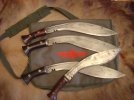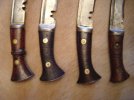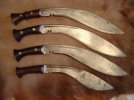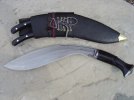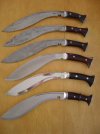- Joined
- Apr 21, 2010
- Messages
- 1,981
I entered the khukuri world knowing I was not and would not be a collector. Only users for me, thank you. Well, that didn’t last long . After amassing a small collection, I knew I had to have a vintage khuk. After going back and forth for a while, I ended up with two standard Mk. IIs made by Pioneer Calcutta, both marked 1943. Content and glad my wife hadn’t killed me for buying those, no one was more surprised than I to find a “WW 2 Kukri” for sale locally. After some haggling (and a few emails to Berk!), I purchased what I later confirmed was an unmarked M43 variant Mk. II with original (or correct at least) karda and chakma!
. After amassing a small collection, I knew I had to have a vintage khuk. After going back and forth for a while, I ended up with two standard Mk. IIs made by Pioneer Calcutta, both marked 1943. Content and glad my wife hadn’t killed me for buying those, no one was more surprised than I to find a “WW 2 Kukri” for sale locally. After some haggling (and a few emails to Berk!), I purchased what I later confirmed was an unmarked M43 variant Mk. II with original (or correct at least) karda and chakma!
So, I now have a tidy little Mk. II non-collection and a few observations on this outstanding khuk. The M43 is thinner and more pointed than the other two. It also has a bit of a hollow forge on the blade. It feels lighter and more like a fighter. Only in the realm of khukuri is a ¼” thick blade a fighting knife! The Pioneers have a little more solid feel with their thicker spines and longer handles. They all feel wonderful in the hand though. I think I actually prefer the feel of the Pioneers, but that could have more to do with handle length. I also believe the roughly 3/8” spine at the bolster with a nice taper to the tip causes the Pioneers to have a solid, but nice balance. Interestingly, the M43 seems a bit better in overall fit and finish, with the bolster appearing to be part of the blade. The Pioneers also seem to have had their handles covered in dark paint or something thick and penetrating, which could be years of cosmoline. One shows some wood grain, but the other will require some elbow grease and possibly Kramer’s Antique Restorer, if not something stronger, while the M43 wood is nicely grained.
As to the sheaths, the M43 came with a traditional sheath of wood covered with a thin leather of some sort. This particular one did not age well due to its handling, but does have most of the frog intact. The military issue sheaths which came with the Pioneers are both marked with British military marks and are dated 1944. Neither has a frog. They seem to be made in a similar manner to the traditional sheath, but are quite thin overall. In spite of this thinness, they seem very solid and strong. The leather appears quite thick. They are protected with a nicely rounded brass (I believe) chape. These sheaths are so well preserved, though dirty and musty, I believe I could take them to the field as is and use them roughly for years. I would love to have this sheath available for my other khuks.
I now know why Bill is so fond of the Mk. II. It is a perfectly handy length and weight, but has plenty enough mass and momentum to chop whatever may need chopping. I believe it would make an ideal edged tool/weapon in the modern age, able to lop off limbs of any type with equal efficiency. It was and is a truly versatile tool. I hope to someday have a modern re-creation to use. These three old soldiers are on display enjoying a well-deserved rest.
For those unfamiliar with the historic M43, I’ll share some of what I learned about this khuk. First, I am no expert on these, far, far from it. Thankfully, there are some experts out there who freely share the fruits of their labor and, to them, I am very grateful. It appears even the experts share some disagreement on who made this khuk and exactly where it fits in the Mk. II picture. It seems apparent the M43 is a variant of the Mk. II, in some form or fashion. It follows the Mk. II measurements, shape, and construction very closely. The defining characteristics which identify it as an M43 seem to be the counter-sunk handle rivets, almost seamless bolster weld, and combination of two rings fore and three rings aft on the handle. It seems most are unmarked, and the few that are marked are only marked “M43”. Maker’s mark, inspector’s mark, company mark….who knows? It just adds to the mystique of this wonderful khuk.
If anyone has further information or can correct any mistake I may have made, please jump right in. The study of these vintage khukuri is fascinating, but often confusing.
And here are some details, for those interested. Switching between inch and metric measurements was a bit confusing, so please excuse any mistakes. Thanks for looking and take care.
Pioneer 1943 Mk. II #1
OAL – 17.5”/44.5 cm
Blade Length – 13.25”/33.65 cm
Weight – 24.8 oz./703 grams
Handle Length – 4.75”/12 cm
Spine Width: @Bolster – .35”/8.8 mm
@Shoulder in front of groove/Sword of Shiva – .26”/6.6 mm
@Tip – .128”/3.2 mm
Tang Width (middle between rings) - .132”/3.3 mm
Handle Width: @First Pin – .98”/24.9 mm
@Second Pin – .98”/24.9 mm
Belly Depth – 2.368”/60.14 mm
Pioneer 1943 Mk. II #2
OAL – 17.5”/44.5 cm
Blade Length – 13.25"/33.65
Weight – 24.2 oz./686 grams
Handle Length – 4.75/12 cm
Spine Width: @Bolster – .333”/8.45 mm
@Shoulder in front of groove/Sword of Shiva – .27”/6.8 mm
@Tip – .113/2.8 mm
Tang Width (middle between rings) - .15”/3.8 mm
Handle Width: @First Pin –1.06”/27 mm
@Second Pin – .97”/24.6 mm
Belly Depth – 2.365”/60.1 mm
Mk. II -M43 Variant, Unmarked
OAL – 17.5”/44.5 cm
Blade Length – 13.25"/33.65 cm
Weight – 23.1 oz./654.8 grams
Handle Length – 4.5”/11.4 cm
Spine Width: @Bolster – .264”/6.7 mm
@Shoulder in front of groove/Sword of Shiva – .243”/6.2 mm
@Tip – .122”/3.1 mm
Tang Width (middle between rings) - .165”/4.2 mm
Handle Width: @First Pin – 1.29”/32.7 mm
@Second Pin – .994”/25.2 mm
Belly Depth – 2.3”/58.4 mm
The three warriors (M43 at the bottom):

My attempt at art:

A Pioneer and the M43 side by side (M43 on bottom):

Close up of Pioneer and M43 handle (M43 on right):

A shot of a Pioneer and the M43 sheathed. My poor M43 sheath!

Close up of M43 K&C:

So, I now have a tidy little Mk. II non-collection and a few observations on this outstanding khuk. The M43 is thinner and more pointed than the other two. It also has a bit of a hollow forge on the blade. It feels lighter and more like a fighter. Only in the realm of khukuri is a ¼” thick blade a fighting knife! The Pioneers have a little more solid feel with their thicker spines and longer handles. They all feel wonderful in the hand though. I think I actually prefer the feel of the Pioneers, but that could have more to do with handle length. I also believe the roughly 3/8” spine at the bolster with a nice taper to the tip causes the Pioneers to have a solid, but nice balance. Interestingly, the M43 seems a bit better in overall fit and finish, with the bolster appearing to be part of the blade. The Pioneers also seem to have had their handles covered in dark paint or something thick and penetrating, which could be years of cosmoline. One shows some wood grain, but the other will require some elbow grease and possibly Kramer’s Antique Restorer, if not something stronger, while the M43 wood is nicely grained.
As to the sheaths, the M43 came with a traditional sheath of wood covered with a thin leather of some sort. This particular one did not age well due to its handling, but does have most of the frog intact. The military issue sheaths which came with the Pioneers are both marked with British military marks and are dated 1944. Neither has a frog. They seem to be made in a similar manner to the traditional sheath, but are quite thin overall. In spite of this thinness, they seem very solid and strong. The leather appears quite thick. They are protected with a nicely rounded brass (I believe) chape. These sheaths are so well preserved, though dirty and musty, I believe I could take them to the field as is and use them roughly for years. I would love to have this sheath available for my other khuks.
I now know why Bill is so fond of the Mk. II. It is a perfectly handy length and weight, but has plenty enough mass and momentum to chop whatever may need chopping. I believe it would make an ideal edged tool/weapon in the modern age, able to lop off limbs of any type with equal efficiency. It was and is a truly versatile tool. I hope to someday have a modern re-creation to use. These three old soldiers are on display enjoying a well-deserved rest.
For those unfamiliar with the historic M43, I’ll share some of what I learned about this khuk. First, I am no expert on these, far, far from it. Thankfully, there are some experts out there who freely share the fruits of their labor and, to them, I am very grateful. It appears even the experts share some disagreement on who made this khuk and exactly where it fits in the Mk. II picture. It seems apparent the M43 is a variant of the Mk. II, in some form or fashion. It follows the Mk. II measurements, shape, and construction very closely. The defining characteristics which identify it as an M43 seem to be the counter-sunk handle rivets, almost seamless bolster weld, and combination of two rings fore and three rings aft on the handle. It seems most are unmarked, and the few that are marked are only marked “M43”. Maker’s mark, inspector’s mark, company mark….who knows? It just adds to the mystique of this wonderful khuk.
If anyone has further information or can correct any mistake I may have made, please jump right in. The study of these vintage khukuri is fascinating, but often confusing.
And here are some details, for those interested. Switching between inch and metric measurements was a bit confusing, so please excuse any mistakes. Thanks for looking and take care.
Pioneer 1943 Mk. II #1
OAL – 17.5”/44.5 cm
Blade Length – 13.25”/33.65 cm
Weight – 24.8 oz./703 grams
Handle Length – 4.75”/12 cm
Spine Width: @Bolster – .35”/8.8 mm
@Shoulder in front of groove/Sword of Shiva – .26”/6.6 mm
@Tip – .128”/3.2 mm
Tang Width (middle between rings) - .132”/3.3 mm
Handle Width: @First Pin – .98”/24.9 mm
@Second Pin – .98”/24.9 mm
Belly Depth – 2.368”/60.14 mm
Pioneer 1943 Mk. II #2
OAL – 17.5”/44.5 cm
Blade Length – 13.25"/33.65
Weight – 24.2 oz./686 grams
Handle Length – 4.75/12 cm
Spine Width: @Bolster – .333”/8.45 mm
@Shoulder in front of groove/Sword of Shiva – .27”/6.8 mm
@Tip – .113/2.8 mm
Tang Width (middle between rings) - .15”/3.8 mm
Handle Width: @First Pin –1.06”/27 mm
@Second Pin – .97”/24.6 mm
Belly Depth – 2.365”/60.1 mm
Mk. II -M43 Variant, Unmarked
OAL – 17.5”/44.5 cm
Blade Length – 13.25"/33.65 cm
Weight – 23.1 oz./654.8 grams
Handle Length – 4.5”/11.4 cm
Spine Width: @Bolster – .264”/6.7 mm
@Shoulder in front of groove/Sword of Shiva – .243”/6.2 mm
@Tip – .122”/3.1 mm
Tang Width (middle between rings) - .165”/4.2 mm
Handle Width: @First Pin – 1.29”/32.7 mm
@Second Pin – .994”/25.2 mm
Belly Depth – 2.3”/58.4 mm
The three warriors (M43 at the bottom):

My attempt at art:

A Pioneer and the M43 side by side (M43 on bottom):

Close up of Pioneer and M43 handle (M43 on right):

A shot of a Pioneer and the M43 sheathed. My poor M43 sheath!

Close up of M43 K&C:




